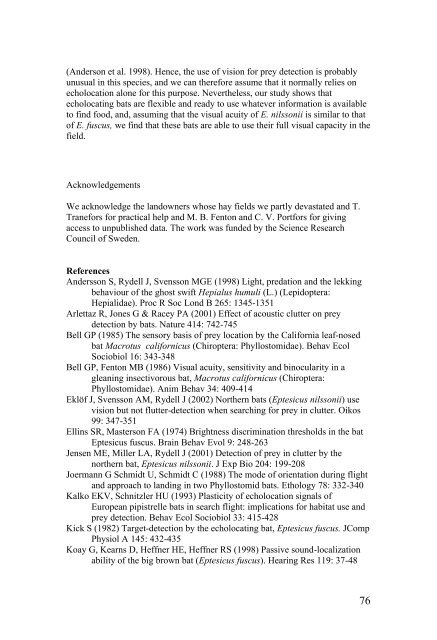Vision in echolocating bats - Fladdermus.net
Vision in echolocating bats - Fladdermus.net
Vision in echolocating bats - Fladdermus.net
You also want an ePaper? Increase the reach of your titles
YUMPU automatically turns print PDFs into web optimized ePapers that Google loves.
(Anderson et al. 1998). Hence, the use of vision for prey detection is probably<br />
unusual <strong>in</strong> this species, and we can therefore assume that it normally relies on<br />
echolocation alone for this purpose. Nevertheless, our study shows that<br />
echolocat<strong>in</strong>g <strong>bats</strong> are flexible and ready to use whatever <strong>in</strong>formation is available<br />
to f<strong>in</strong>d food, and, assum<strong>in</strong>g that the visual acuity of E. nilssonii is similar to that<br />
of E. fuscus, we f<strong>in</strong>d that these <strong>bats</strong> are able to use their full visual capacity <strong>in</strong> the<br />
field.<br />
Acknowledgements<br />
We acknowledge the landowners whose hay fields we partly devastated and T.<br />
Tranefors for practical help and M. B. Fenton and C. V. Portfors for giv<strong>in</strong>g<br />
access to unpublished data. The work was funded by the Science Research<br />
Council of Sweden.<br />
References<br />
Andersson S, Rydell J, Svensson MGE (1998) Light, predation and the lekk<strong>in</strong>g<br />
behaviour of the ghost swift Hepialus humuli (L.) (Lepidoptera:<br />
Hepialidae). Proc R Soc Lond B 265: 1345-1351<br />
Arlettaz R, Jones G & Racey PA (2001) Effect of acoustic clutter on prey<br />
detection by <strong>bats</strong>. Nature 414: 742-745<br />
Bell GP (1985) The sensory basis of prey location by the California leaf-nosed<br />
bat Macrotus californicus (Chiroptera: Phyllostomidae). Behav Ecol<br />
Sociobiol 16: 343-348<br />
Bell GP, Fenton MB (1986) Visual acuity, sensitivity and b<strong>in</strong>ocularity <strong>in</strong> a<br />
glean<strong>in</strong>g <strong>in</strong>sectivorous bat, Macrotus californicus (Chiroptera:<br />
Phyllostomidae). Anim Behav 34: 409-414<br />
Eklöf J, Svensson AM, Rydell J (2002) Northern <strong>bats</strong> (Eptesicus nilssonii) use<br />
vision but not flutter-detection when search<strong>in</strong>g for prey <strong>in</strong> clutter. Oikos<br />
99: 347-351<br />
Ell<strong>in</strong>s SR, Masterson FA (1974) Brightness discrim<strong>in</strong>ation thresholds <strong>in</strong> the bat<br />
Eptesicus fuscus. Bra<strong>in</strong> Behav Evol 9: 248-263<br />
Jensen ME, Miller LA, Rydell J (2001) Detection of prey <strong>in</strong> clutter by the<br />
northern bat, Eptesicus nilssonii. J Exp Bio 204: 199-208<br />
Joermann G Schmidt U, Schmidt C (1988) The mode of orientation dur<strong>in</strong>g flight<br />
and approach to land<strong>in</strong>g <strong>in</strong> two Phyllostomid <strong>bats</strong>. Ethology 78: 332-340<br />
Kalko EKV, Schnitzler HU (1993) Plasticity of echolocation signals of<br />
European pipistrelle <strong>bats</strong> <strong>in</strong> search flight: implications for habitat use and<br />
prey detection. Behav Ecol Sociobiol 33: 415-428<br />
Kick S (1982) Target-detection by the echolocat<strong>in</strong>g bat, Eptesicus fuscus. JComp<br />
Physiol A 145: 432-435<br />
Koay G, Kearns D, Heffner HE, Heffner RS (1998) Passive sound-localization<br />
ability of the big brown bat (Eptesicus fuscus). Hear<strong>in</strong>g Res 119: 37-48<br />
76


